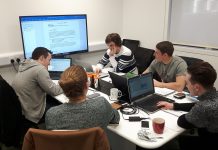Universities are increasingly investing in technology-enhanced learning, but education consultant Peter Chatterton writes that to get the maximum benefit from this investment, they should learn from experiences outside the education sector.
As last week’s blogpost by Sarah Davies showed, universities are demonstrating plenty of promising innovations in technology-enhanced learning.
But interviews with senior managers at the start of the Changing the Learning Landscape programme confirmed that the widespread roll-out of promising innovations remains a challenge. This view is supported by the students who took part in the programme, who cited inconsistencies in processes and practices as being a major bug-bear.
As someone who’s worked on change projects in both universities and the business and manufacturing sectors, I’d like to offer some suggestions for how universities could derive greater benefits from their technology innovation.
1. Adopting a more “orchestrated” approach to innovation
Most universities have minimal “systems” in place to convert experiments in technology-enhanced learning into systemic and embedded innovation, i.e. embedding innovations in teaching practices throughout the institution. The private sector is generally better at this: innovation and R&D is more “orchestrated” with systems to take new ideas, grow them and implant them into the organisations’ ways of working, business and culture. Universities must adopt such practices.
2. Aligning technology-enhanced learning with strategic goals
Too often, technology-enhanced learning is not fully aligned with strategic goals and anecdotal evidence suggests that senior managers do not always appreciate the potential strength of this link. It is at the “local” level in particular where heads of departments need to formulate plans to incorporate technology-enhanced learning – to respond to student/employer needs, enhance student employability and provide flexible and equitable learning experiences – and where strategic links need to be most explicit.
3. Evaluating impact – over longer time frames
The automotive sector has adopted Japanese-style manufacturing methods driven by sector-wide measures of quality, cost and delivery (QCD) which has proven highly successful. Universities could consider a similar framework for measuring impact based around “QER” – Quality, Efficiency and Responsiveness to student/employer demands. There would need to be a balance between qualitative and quantitative measures taking into account the differences between education and manufacturing. Continuous improvement programmes could also learn that longer time-frames are required to achieve real impact.
4. Adopting “lean” methodologies
“Lean” approaches, as pioneered in the automotive sector, can pave the way not just to greater efficiencies but also to enhancements in the use of technology. Lean has been successfully applied in a diverse range of private and public sector organisations, including Silicon Valley and universities e.g. to streamline course design and validation processes. A lean process focusing on understanding what students, staff and employers value most can help to design processes and systems that eliminate waste, duplication and unnecessary tasks as well as maximising the opportunities afforded by integrated ICT systems.
5. Greater use of benchmarking as part of continuous improvement
Around a decade ago, the Higher Education Academy / Jisc ran a national e-learning benchmarking programme to support universities in evaluating their progress with e-learning and inform their strategic plans. It also supported subsequent improvement programmes, though few institutions chose to re-benchmark to evaluate impact. Compare this with the automotive sector where continuous improvement is a cornerstone of sustainability with regular benchmarking – internally, in the sector and with other sectors. Universities should adopt similar practices and start off with updating the benchmarking toolkits to reflect current best practices.
5. Senior managers demonstrating leadership with technology
I was recently working with a University where the Pro-Vice Chancellor who is leading change in technology-enhanced learning is also a practitioner in this area – he learns and uses technologies in his teaching practices. Other senior managers should follow suit – it helps to develop understanding that can inform policies and decision-making and inspires others to follow.
6. Coaching skills to inspire academics and senior managers to change
The automotive sector has been successful in recognising the need for appropriate skills to support culture change programmes, whereas university change support personnel in technology-enhanced learning tend to be home-grown often with technology as a key background. I believe that coaching skills are an important requirement for influencing academics and senior managers to change and such skills should be provided as a core element of support for staff professional development.
7. Ensuring ICT infrastructure is fit-for-purpose
The automotive sector has some highly effective and efficient integrated computer-aided manufacturing IT and robotics systems and the university sector could learn two key lessons here. First, systems need to be more integrate, e.g. student records, virtual learning environments and e-portfolios. This would pave the way for many potential benefits in the form of efficiencies and data/learner analytics. A personal view is that integration strategies should be focused around student mobile devices – their device of choice! Secondly, an “it just works” approach to technology needs to become commonplace to ensure world-class quality in implementation of maintenance, training and support, including ensuring classroom and online technologies are totally reliable.
8. Extending innovative student-staff partnerships to include employers
In her blog, Sarah Davies described highly innovative student-staff partnerships that universities are adopting to drive new ideas for improving student learning e.g. Winchester’s student fellows. Such partnerships could be further enhanced through bringing employers into them.
I firmly believe that universities need to be more outward looking when it comes to student learning and the role of technology. I hope some of the ideas mentioned might inspire some new approaches.
Dr Peter Chatterton is a consultant and academic who was involved in Changing the Learning Landscape, a project to transform strategic approaches to technology across higher and further education. He is leading a workshop on technology-enhanced learning at this month’s 4th annual efficiency conference.








